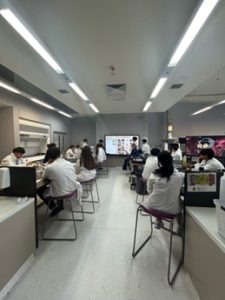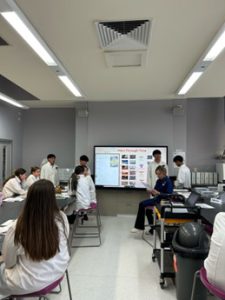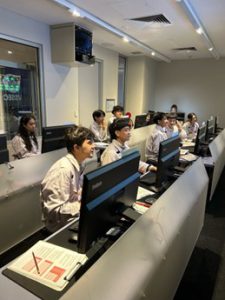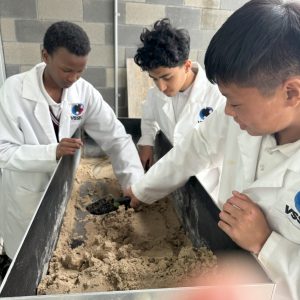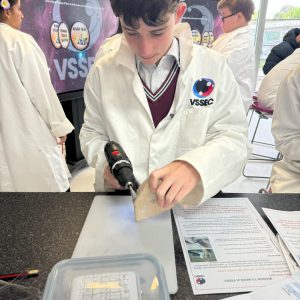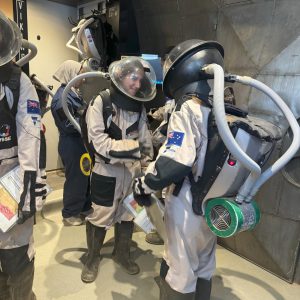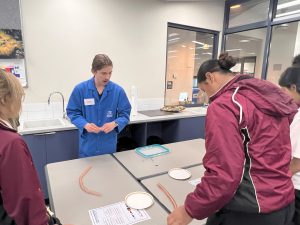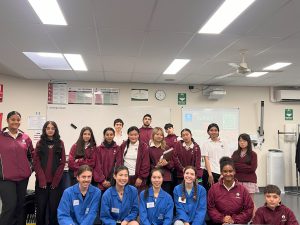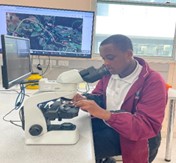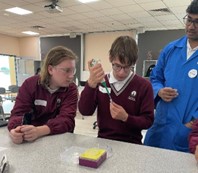8B Mission to Mars at Victorian Space Education Centre
On the 6th of November 8B went to VSSEC, a space and science education centre located in Strathmore. At VSSEC we were able to simulate a mission on mars and even put on our own spacesuits with astronaut helmets and everything. We collected different rocks, set up different devices and located various different spots on a replica of Mars. We were also able to practise and use our communication skills simulating what it would be like to control and direct the mission on mars, talking to our peers who would be on that mission to help them successfully fulfil their tasks and overall create a successful mission. At the end of the day we went into a lab to conduct experiments and organise the different types of rocks we collected during our simulation. My overall experience was very enjoyable and I would definitely like to come back another time. It was very interesting to learn about the cold and dangerous conditions of mars and the rocks that formed on various different landforms on mars like volcanoes, deserts and lakes. – Jadyn Nguyen 8B
On the 6th of November, the class of 8B visited VSSEC, a science education centre. When we arrived, we were greeted by the amazing Chloe, Eve and Prima, who were our guides for the day. They were really helpful in explaining our tasks and guiding us during our journey to Mars. We were all given roles to complete research on an imitation of the surface of Mars. Although it was a replica, when we put on the space suits and had our own roles to fulfil it felt like we were really astronauts in space heading to Mars. It was really interesting to learn about the different aspects of Mars through our jobs. Using space technology, we sampled rocks, checked for radiation, checked the temperatures of the rocks… With this information, we later proved facts about the rocks in Mars, such as their age, where they are found, what type of rock they are. Other than exploring Mars, we also used our communication skills to direct and assist our peers in completing their jobs in mission control. Finally, at the end of the day we gathered in a lab to combine the knowledge in our scientific fields to conduct experiments and come to conclusions about the rocks we collected on Mars. I really enjoyed this excursion and I would definitely recommend visiting VSSEC at least once. This excursion was an awesome opportunity to develop our communication skills and learn about science. I would say the most interesting thing we learnt was where the different rocks were formed and the most interesting thing we did would definitely be experiencing Mars and using 3D glasses to watch the launching of our spacecraft. – An Nguyen 8B
8J Mission to Mars at Victorian Space Education Centre
Attending the Victorian Space Science Education Centre (VSSEC) was a mind-boggling experience. We had the chance to collaborate in teams, using our problem-solving abilities to perform a variety of tasks based on the roles assigned, to conduct a geological survey of Mars’ surface. Wearing specially designed spacesuits, we got a taste of life as both astronauts and mission control officers for a day. Our shared objective was to identify different types of rocks and explore their connections towards Mars, helping us better understand the planet’s history and environment. This experience not only expanded our knowledge of space but also made learning enjoyable. – Julia Ho 8J
Mission to Mars: A Journey Beyond the Stars
Attending the Victorian Space Science Education Centre (VSSEC) was an unforgettable experience. This hands-on program not only brought space exploration to life, but also reinforced important skills like teamwork and problem-solving. We worked in teams, using critical thinking to complete tasks inspired by real astronaut missions. Wearing specially designed spacesuits, we explored life as astronauts and mission control officers during a simulated geological survey of Mars. Our mission was to collect different types of core samples on Mars to learn about its environment and history. This immersive experience made learning both educational and fun!
Teamwork in Space Exploration
The program divided participants into two teams: Team Viking and Team Mariner, each made up of astronauts and mission control officers. Both groups worked closely together to complete the mission.
Astronauts wore spacesuits and simulated exploring the surface of Mars. They collected core samples, tested equipment, and searched for signs of life. Mission control officers, stationed on Earth, guided the astronauts by relaying instructions, solving problems, and monitoring equipment. Together, both teams worked efficiently to ensure the mission’s success. Each role was crucial, from geologists studying rock formations to communication specialists ensuring seamless coordination. For example, when an astronaut encountered a technical issue with their equipment, mission control officers worked together to resolve the problem in real-time, demonstrating the importance of collaboration.
Why This Program Matters
The Mission to Mars program highlighted the importance of teamwork, critical thinking, and problem-solving in achieving a shared goal. It also inspired us to consider careers in science, technology, engineering, and mathematics (STEM). By simulating real-world challenges faced by astronauts and mission control officers, the program emphasised how these skills play a role in space exploration and beyond.
This program is more than just a simulation—it’s a gateway to understanding space exploration and the skills it requires. Whether you’re fascinated by space or eager to tackle exciting challenges, the Mission to Mars experience is a must-try. Who knows? One day, you might be part of a real mission exploring the stars!
Ready to Embark on Your Own Mission?
If you’re inspired by the Mission to Mars program and want to encourage your child or students to explore the wonders of space, consider enrolling them in this exciting program or similar ones. It’s a unique opportunity to spark curiosity, inspire future careers in STEM, and experience the thrill of space exploration firsthand. Don’t miss out—sign up for the next Mission to Mars experience and let your students embark on a journey beyond the stars! – Louis Lam 8J
Ms Phuong Le – Science Teacher | Middle Sub School Coordinator
Melbourne University Science Roadshow
On Wednesday 27 November, two Year 9 Science classes 9J and 9L, along with Ms. Kaanchana Pothapragada, Ms. Marion Mortimer, and Ms. Angela Hanley took part in the Science Roadshow incursion organised by science students from the University of Melbourne.
The Science Roadshow is an outreach program run by the Faculty of Science and aimed at encouraging students from a diverse range of backgrounds to study science and go to University, and ensure any barriers they are facing do not stop them from achieving their career goals.
During this session students were involved in watching science demonstrations which related to Physics, Geoscience, Engineering and Biological Sciences, then broke off into small groups to participate in hands-on activities such as observing sheep’s lungs, using magnet to power the movement of The Electromagnetic Train, solving mathematical problems to engineer drones through maps, and analysing crystal formation in different rocks. The group also watched videos, and received insights from the presenters about their background, experiences at University and future career plans.
Ms Kaanchana Pothapragada – Science Teacher
Year 10 Forensic Science Investigation at GTAC
In Term 4, our two Year 10 Forensic Science classes embarked on a journey to the Gene Technology Access Centre (GTAC) in Parkville accompanied by their Teachers, Ms Mortimer and Mr Tran, the Assistant Middle School Coordinator, Mr Alexandrescu and Education Support Teacher, Ms Karen De Amyand Hegarty.
Inspired by real events, students took on the role of trainee Wildlife Officers for the Conservation Regulator and investigated the illegal killing and dumping of many unidentified birds of prey. Working in small groups facilitated by a scientist mentor, students used research grade microscopes and technologies to investigate the case. Different exhibits were examined to discover if the birds were a protected species, what murder weapon(s) were used, and attempted to identify a prime suspect with a likely motive. Finally, students had to decide if there was enough supporting evidence to arrest any of the suspects.
The forensic science investigation was excellent, and the students really enjoyed working with ‘real’ young scientists to solve the crime.
Ms Marion Mortimer – Science Teacher | Scholarships Leader
